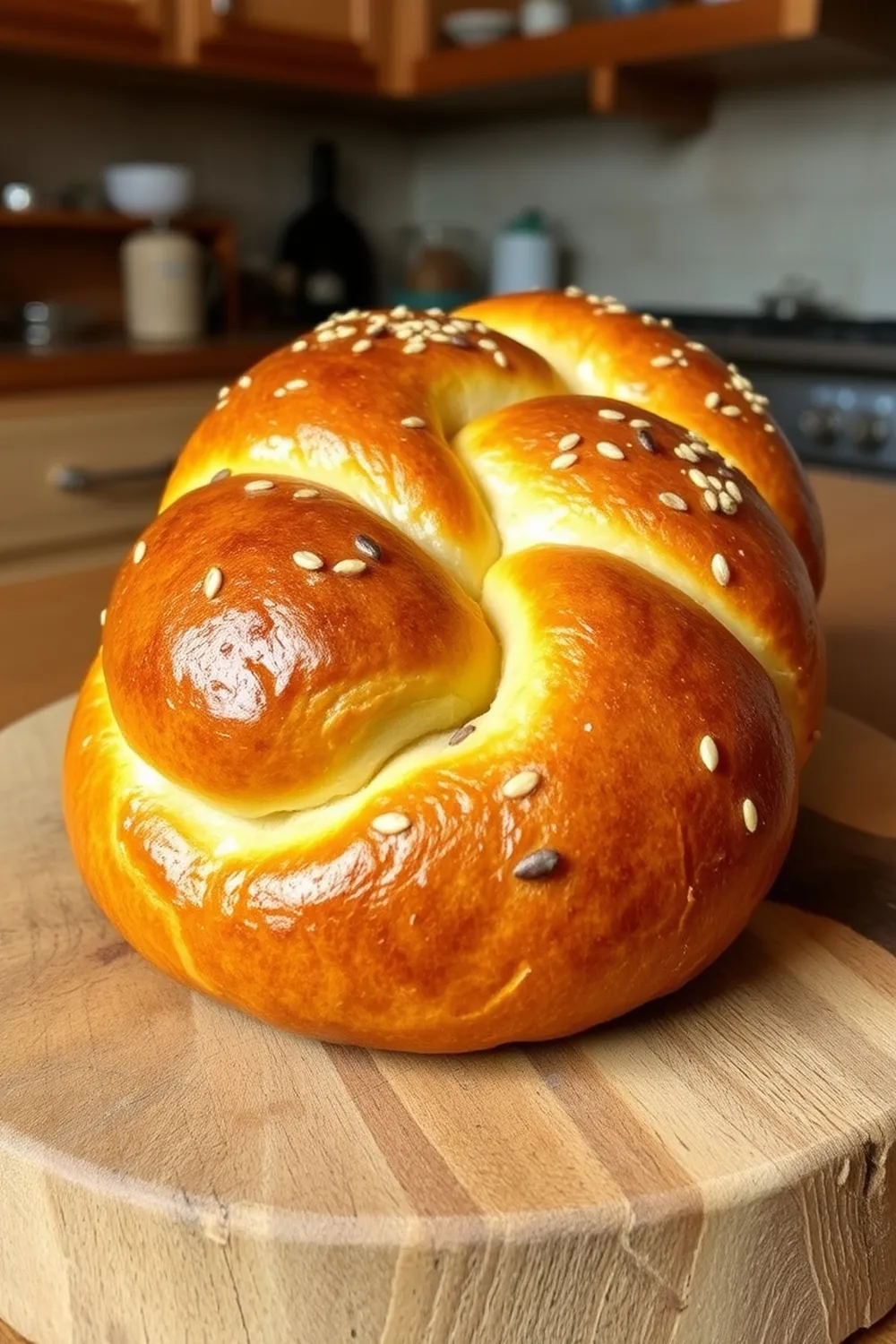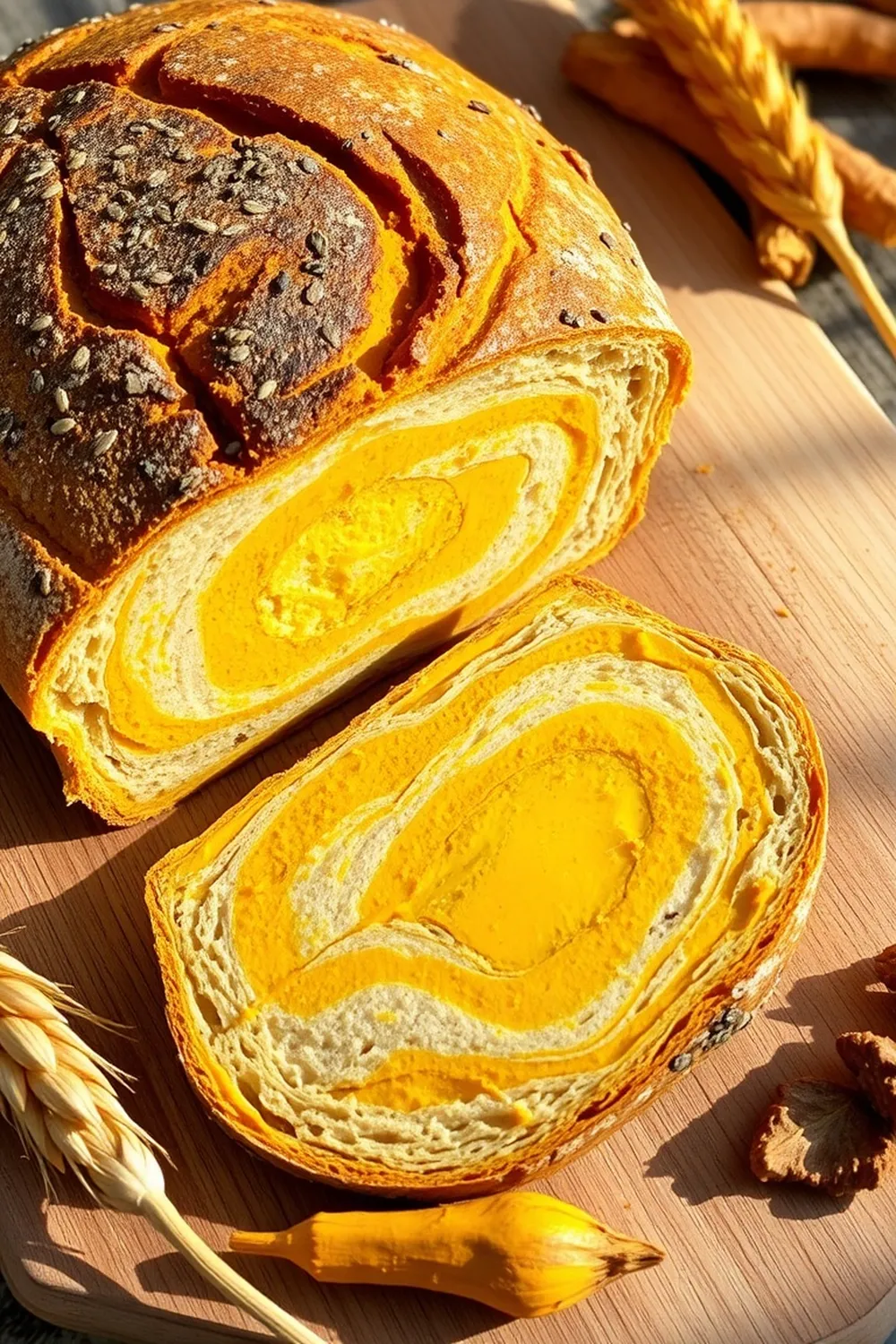- In a stand mixer bowl, combine flour, salt, sugar, yeast, ground mastic, and Mahlepi.
- Heat butter and milk until melted. Let cool slightly, then add to dry ingredients.
- Beat eggs (reserving 1 tablespoon for egg wash) and mix into dough until soft and supple (7 minutes on medium-high speed).
- Transfer dough to a greased bowl, cover, and let rise for 2 hours, folding or stretching after 1 hour.
- Divide dough into 3 equal parts. Roll each into 17-inch ropes and braid together, tucking in the ends.
- Place braid on a parchment-lined baking sheet. Let rise for 30 minutes or until springy to the touch.
- Preheat oven to 350°F (177°C). Brush braid with egg wash; sprinkle with sesame seeds and almonds.
- Bake for 20 minutes. Add a dyed egg to the center, rotate the pan, and bake for 10 more minutes until golden brown.
- Cool before slicing. Serve with Easter eggs as a tradition.
- Calories:2078 kcal25%
- Energy:8694 kJ22%
- Protein:59 g28%
- Carbohydrates:292 mg40%
- Sugar:52 mg8%
- Salt:1446 g25%
- Fat:75 g20%
Last Updated on 6 months ago by Neha Deshmukh
Traditional Greek Easter Tsoureki Bread Recipe – Mastic & Mahlepi
Introduction
Oh, Tsoureki! Just the smell of this sweet, fragrant bread baking transports me right back to my friend Eleni’s kitchen in Athens. She taught me this recipe years ago, and it’s become a tradition in my home ever since, especially around Easter. It’s more than just bread; it’s a symbol of rebirth and a taste of springtime. I’m so excited to share this traditional Greek Easter Tsoureki recipe with you – it’s a little bit of work, but so worth it!
Why You’ll Love This Recipe
This Tsoureki isn’t your average sweet bread. The unique combination of mastic and mahlepi gives it a flavor you won’t find anywhere else – floral, slightly piney, and utterly addictive. Plus, the beautiful braided loaf adorned with red-dyed eggs is a stunning centerpiece for your Easter table (or any special occasion, really!). It’s a truly special treat that’s sure to impress.
Ingredients
Here’s what you’ll need to create this delicious Tsoureki:
- 300g all-purpose flour
- 50g butter
- ¾ cup + 1 tablespoon milk (about 200ml)
- 50g sugar
- 2 large eggs (plus 1 tbsp for egg wash)
- 7g yeast
- 2g salt
- 5 tears mastic (more on this below!)
- ½ teaspoon Mahlepi
- 1 hard-boiled red dyed egg
- 2 tablespoons sesame seeds
- 2 tablespoons halved almonds
Ingredient Notes
Let’s talk about a few key ingredients that make this Tsoureki so special:
- Mastic: This is a resin from the mastic tree, grown on the island of Chios, Greece. It has a unique, almost pine-like flavor. You’ll need to “cry” the mastic – that means kneading it with a little sugar until it becomes soft and pliable. Don’t skip this step! It really unlocks the flavor. It’s a bit hard to find outside of specialty stores, but trust me, it’s worth the hunt.
- Mahlepi: This is a spice made from the seeds of a cherry tree. It adds a beautiful floral aroma and flavor. You can usually find it in Middle Eastern or Greek grocery stores.
- Red Dyed Egg: The red egg symbolizes the blood of Christ and rebirth. It’s traditionally placed in the center of the braid. It’s a beautiful and meaningful addition! You can find pre-dyed eggs, or dye your own.
Step-By-Step Instructions
Alright, let’s get baking!
- In a stand mixer bowl, combine the flour, salt, sugar, yeast, mastic, and mahlepi. Give it a good whisk to make sure everything is evenly distributed.
- In a saucepan, heat the butter and milk until melted. Let it cool slightly – you don’t want to cook the eggs! – then add it to the dry ingredients.
- Beat the eggs (reserving 1 tbsp for the egg wash) and mix into the dough. Beat for about 7 minutes on medium-high speed until the dough is soft and supple. It should be slightly sticky, but pulling away from the sides of the bowl.
- Transfer the dough to a lightly greased bowl, cover it with plastic wrap, and let it rise in a warm place for about 2 hours. After an hour, gently fold or stretch the dough – this helps develop the gluten and gives you a lighter, airier bread.
- Once the dough has doubled in size, gently punch it down and divide it into 3 equal parts. Roll each part into a 17-inch rope.
- Now for the braid! Carefully braid the three ropes together, tucking the ends underneath to seal them.
- Place the braid onto a parchment-lined baking sheet. Cover it loosely and let it rise for another 30 minutes, or until it’s springy to the touch.
- Preheat your oven to 350°F (177°C). Brush the braid with the reserved egg wash and sprinkle generously with sesame seeds and halved almonds.
- Bake for 20 minutes. Then, gently press the red dyed egg into the center of the braid. Rotate the pan and bake for another 10 minutes, or until the bread is golden brown.
- Let the Tsoureki cool completely on a wire rack before slicing and serving.
Expert Tips
- Don’t overwork the dough! Overkneading can result in a tough bread.
- A warm, humid environment is ideal for rising. If your kitchen is cold, try placing the bowl in a slightly warmed oven (turned off, of course!).
- If the braid feels like it’s shrinking back, let it rest for a few minutes before continuing.
Variations
- Vegan Adaptation: Substitute the butter with vegan butter and the eggs with flax eggs (1 tbsp flaxseed meal + 3 tbsp water per egg). Use plant-based milk.
- Gluten-Free Adaptation: Use a good quality gluten-free flour blend designed for baking. You may need to adjust the liquid slightly.
- Spice Level Adjustment: For a milder flavor, reduce the mahlepi to ¼ teaspoon. For a more aromatic bread, add a pinch of cardamom.
- Festival Adaptations: This bread is traditionally made for Easter, but it’s delicious any time of year! Feel free to decorate it with different toppings for other celebrations.
Serving Suggestions
Tsoureki is wonderful on its own, but it’s also delicious served with a simple cup of coffee or tea. Traditionally, it’s eaten with Easter eggs – a fun and festive tradition! It also pairs beautifully with a dollop of Greek yogurt and a drizzle of honey.
Storage Instructions
Tsoureki is best enjoyed fresh, but it will keep for up to 3 days stored in an airtight container at room temperature. You can also freeze it for up to a month.
FAQs
- What is Tsoureki traditionally eaten with? Traditionally, Tsoureki is eaten with Easter eggs, symbolizing rebirth and new life.
- Can I make Tsoureki dough ahead of time? Yes! You can make the dough up to a day in advance. Let it rise once, then punch it down and refrigerate it overnight. Bring it to room temperature before braiding and baking.
- What does Mastic taste like and can I substitute it? Mastic has a unique, piney, slightly floral flavor. It’s hard to substitute, but you could try a tiny drop of pine needle extract (use very sparingly!).
- What is Mahlepi and where can I find it? Mahlepi is a spice made from cherry seeds, adding a floral aroma. Look for it in Middle Eastern or Greek grocery stores.
- How do I achieve the perfect braid for Tsoureki? Practice makes perfect! Keep the ropes of dough even in thickness and gently braid them, tucking the ends underneath to secure them. Don’t worry if it’s not perfect – it will still taste delicious!










